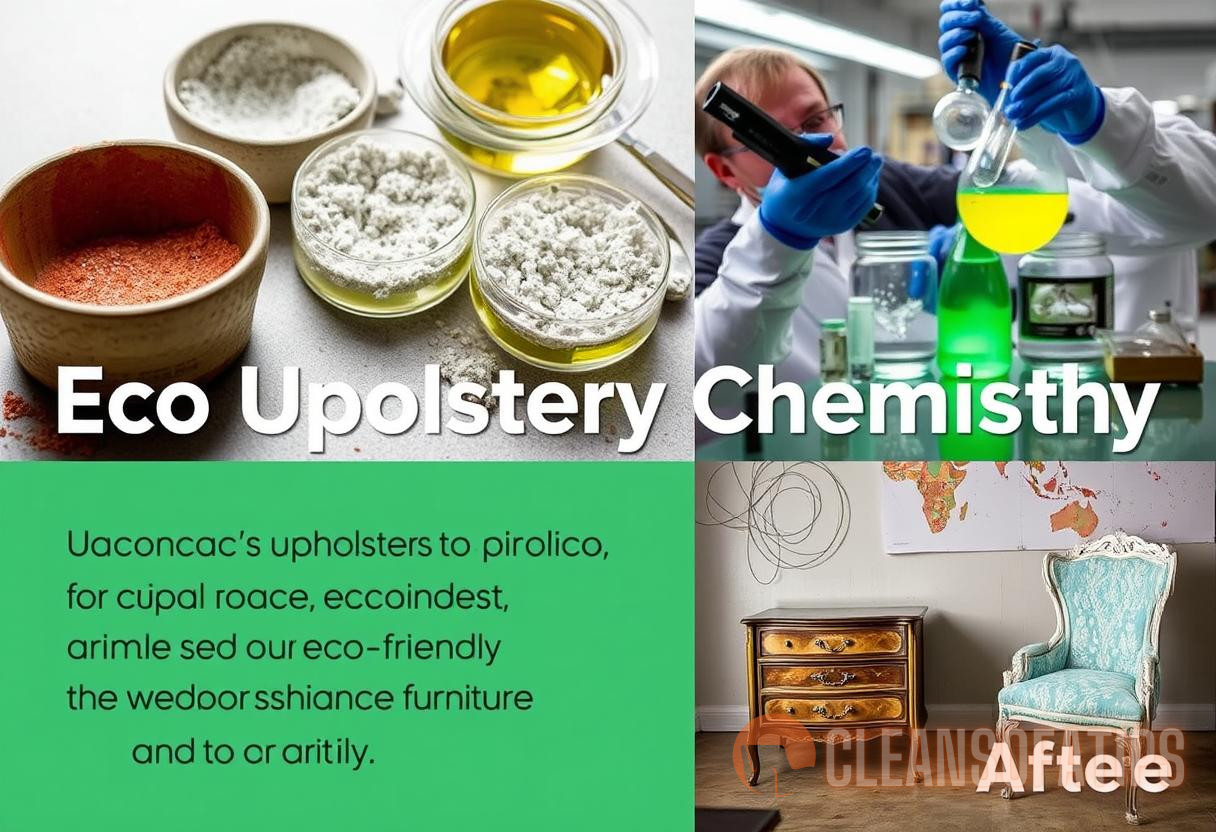Nature’s Palette: Exploring the Chemistry of Eco-Conscious Upholstery Restoration
In recent years, the demand for eco-conscious practices has significantly increased, reflecting a heightened awareness of environmental sustainability. This phenomenon extends to various sectors, including the upholstery industry. By delving into the realm of eco upholstery chemistry, we uncover practices and innovations that not only enhance the aesthetic appeal of furniture but also foster a sustainable future.
The Importance of Eco-Conscious Upholstery Restoration
Upholstery restoration is an excellent way to breathe new life into old furniture while minimizing environmental impact. The upholstery industry has traditionally relied on chemicals and materials that can be harmful to both personal health and the environment. By adopting eco-conscious methods and exploring the chemistry behind them, we can effectively rejuvenate furniture and contribute to a healthier planet. Here are several reasons underpinning the importance of eco-conscious upholstery restoration:
- Reduced Chemicals Exposure: Many conventional upholstery materials involve harmful volatile organic compounds (VOCs) which can degrade indoor air quality.
- Resource Conservation: Restoring existing furniture reduces the need for new resources, lowering your ecological footprint.
- Waste Reduction: Upholstery restoration diverts waste from landfills, promoting circular economy principles.
- Financial Savings: Restoring upholstery can be significantly less expensive than purchasing new furniture.
Understanding Eco Upholstery Chemistry
At the heart of eco-conscious restoration lies the evolving field of eco upholstery chemistry. This encompasses a range of materials and methods aimed at minimizing negative environmental impact while maximizing durability and comfort. The chemistry behind these approaches reveals how innovative processes transform traditional upholstery into eco-friendly versions. Key elements of eco upholstery chemistry include:
Sustainable Materials
Sustainable materials are foundational to achieving eco-conscious upholstery. Various fabric types and filling materials are emerging as environmentally friendly alternatives. Some notable options include:
- Organic Cotton: Grown without synthetic pesticides or fertilizers, organic cotton is both biodegradable and less harmful to the environment.
- Bamboo Fabric: Bamboo is a highly renewable resource; its fibers can be processed into soft, durable fabric without harmful chemicals.
- Recycled Polyester: Made from recycled plastic bottles, recycled polyester reduces waste and energy consumption during manufacturing.
- Natural Latex: Derived from rubber trees, natural latex is biodegradable and does not off-gas harmful chemicals.
Non-Toxic Finishes
Conventional upholstery often utilizes finishes that can emit harmful substances. However, several non-toxic alternatives are now being developed within the field of eco upholstery chemistry. These include:
- Water-Based Adhesives: Unlike solvent-based options, water-based adhesives are less harmful and produce fewer harmful emissions.
- Plant-Based Dyes: Utilizing natural dye sources, such as fruits and plants, reduces environmental toxins produced during dyeing.
- Natural Oil Finishes: Finishes made from natural oils, such as linseed or tung oil, provide protection without the hazards associated with synthetic counterparts.
Real-World Applications: Case Studies
To better understand the effectiveness of eco upholstery practices, we can examine several case studies involving eco upholstery chemistry in action. These examples illustrate practical applications and inspiring success stories in upholstery restoration.
Case Study: Green Chair Company
The Green Chair Company, based in Raleigh, North Carolina, is a standout example of eco-conscious upholstery restoration. This nonprofit organization specializes in refurbishing furniture that would otherwise end up in landfills. They utilize sustainable materials, such as eco-friendly fabrics and natural latex foam, thereby enhancing their products’ environmental sustainability. Their restoration process not only uses non-toxic finishes but also educates the community about the benefits of eco-friendly practices.
Case Study: Reclaimed Wood Furniture
Another compelling example is found with companies like Reclaimed Wood Exchange that focus on transforming salvaged materials into beautiful furniture. By incorporating upholstery with eco-friendly fabrics, they exemplify the integration of eco upholstery chemistry into woodworking and upholstery. Their approach significantly reduces waste while maintaining high-quality, aesthetically pleasing products.
The Science Behind Eco-Friendly Upholstery

Understanding the scientific principles that guide eco upholstery chemistry is vital for appreciating its advantages. Here are a few essential concepts:
Biodegradability
The biodegradability of materials used in upholstery is crucial for reducing long-term environmental impact. Eco-friendly fabrics tend to decompose naturally, in contrast to synthetic materials that can take decades to break down. For instance:
– Organic Cotton: Completely biodegradable as it derives from natural plant sources. – Bamboo Fabric: Breaks down efficiently due to its natural composition, returning nutrients to the soil.Greenhouse Gas Emissions
The production of conventional upholstery materials contributes significantly to greenhouse gas emissions. Eco-conscious options seek to reduce these emissions through:
– Sustainable Farming Practices: Organic cotton and bamboo cultivation often requires less energy and fewer chemicals, showcasing a smaller carbon footprint. – Recycling Processes: Utilizing waste materials like plastic bottles in manufacturing contributes to a closed-loop system, minimizing energy consumption and carbon output. For more insights on recycling processes, visit the EPA Recycling page.Techniques for DIY Eco Upholstery Restoration
Those interested in engaging in upholstery restoration can do so with a green perspective by employing specific techniques that adhere to eco upholstery chemistry principles. Below are useful steps and methods:
Preparation and Materials Gathering
Before beginning restoration, ensure that the following materials are eco-friendly:
- Natural, organic fabrics or recycled materials
- Non-toxic adhesives and finishes
- Natural stuffing, such as organic cotton or wool
Step-by-Step Restoration Process
Below is a simplified restoration process that can serve as a guide for DIY enthusiasts:
- Assess and Clean: Evaluate the piece for any damages, then clean using natural soaps and water to avoid harmful chemical cleaners.
- Disassemble: Carefully remove any existing upholstery to expose the frame.
- Repair: Use non-toxic wood fillers for any frame damages before proceeding.
- Uphold Eco Chemistry: When upholstering, use sustainable materials and adhere to green-textile practices.
- Finishing Touches: Select eco-friendly finishes and glues to finalize the restoration.
The Future of Eco Upholstery Chemistry
The evolution of eco upholstery chemistry signals a burgeoning revolution within the upholstery industry. With increasing consumer demand for sustainable products, ongoing research and development will likely introduce innovative materials and techniques. Below are some trends indicating the future:
- Smart Textiles: The rise of textiles embedded with technology that can signify sustainability status.
- Bioplastics: A new frontier in sustainable fabric creation utilizing bio-based resources.
- Local Sourcing: A shift towards materials sourced closer to manufacturing to reduce environmental impact.
As more people wake up to the necessity of sustainability, the expectation is that eco-friendly practices, including upholstery restoration, will become the norm rather than the exception.
Conclusion
By exploring the chemistry behind eco-conscious upholstery restoration, we unearth a path laden with sustainable options that promote both aesthetic appeal and environmental responsibility. The thoughtful integration of eco-friendly practices not only enhances our living spaces but also contributes to a healthier and more sustainable planet. Implementing these methods and understanding the underlying chemistry opens new horizons for the upholstery industry, ensuring that we work harmoniously with nature to protect it for future generations.



